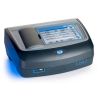Thermo Orion AquaMate Spectrophotometers
Features
- Includes over 260 preprogrammed test methods
- Operators can create their own custom methods and calibration curves
- Supports Orion AQUAfast, Merck or CHEMetrics chemistries
- Free ground shipping
- Expedited repair and warranty service
- Lifetime technical support
- More
Overview
The Thermo Scientific Orion AquaMate 7100 Visible and 8100 UV-Visible Spectrophotometers are designed to meet the specific needs of water and wastewater analysis laboratories. Includes over 260 preprogrammed methods for easy and convenient measurements using Thermo Scientific Orion AQUAfast, Merck, and CHEMetrics reagents. The instruments allow the ultimate flexibility in vial sizes and accommodate a wide range of round, square and rectangular vials with three vial holder options.
Customizable Methods
All preprogrammed methods are preloaded on the included USB memory stick to allow operators to add or remove methods as desired. Custom methods using the standard curve function can be uploaded through the USB, making it possible for most colorimetric reagents to be used. Making it possible for most colorimetric reagents to be used. Visit thermofisher.com/aquamateuvvis for the most current list of US EPA-compliant reagent chemistry methods.
Mechanics
Magnetically retained, easy-to-clean vial holders are available for 12 to 25 mm round, 10 mm square and 20 to 100 mm rectangular vials. An adjustable round vial holder is also included/available that accommodates 13 to 24 mm round vials. The instruments allow a one-point adjustment on any preprogrammed method to correct for variations in batch reagent chemistries. Preprogrammed methods can also be adapted for new chemistries or operators can create their own custom methods.
Performance Verification Testing
Orion AquaMate 7100 Visible and 8100 UV-Visible Spectrophotometers include performance verification tests that ensure wavelength accuracy and instrument functionality. In accordance with GLP and GMP, each verification report gives the time, date and instrument serial number. The built-in wavelength accuracy test is compatible with either the internal lamp or external calibrated standards.
Parameters
The preprogrammed test methods allow simple, accurate analysis of:
|
Acid capacity |
Chloride |
Fluoride |
Molybdenum |
Platinum |
- (1) AquaMate Spectrophotometer
- (1) Test Tube Holder for Vials and Test Tube from 12mm to 25mm OD
- (1) AquaMate Water Analysis Methods Software
- (1) Dust Cover
- (1) External Power Supply
- (1) North America Power Cable (NEMA 5-15)
- (1) European Power Cable (CEE 7/7)
- (1) UK Power Cable (BS 1362)
In The News
Combating Water Insecurity in Saskatchewan with Real-Time Data
The prairies of Saskatchewan can be described as one of the least water-secure parts of Canada, making water quality monitoring essential for informed resource management in a region already facing water insecurity. While natural physical properties worsen some of the poor water quality conditions in the region, others are connected to land use. Having grown up spending summers on the shores of Lake Huron, Helen Baulch, an associate professor at the School of Environment and Sustainability at the University of Saskatchewan , has always been dedicated to the protection of water resources. Looking back fondly at her childhood playing along the shore, Baulch also recalls the invasion of quagga mussels during her teenage years and watching the lake change as a result.
Read MoreSeametrics Turbo Turbidity Logger: Boost your Turbidity Monitoring
The Seametrics Turbo Turbidity Logger is a self-cleaning turbidity sensor capable of internally logging over 260,000 data records. The sensor enables researchers, compliance officers, and contractors to monitor turbidity in various applications, from construction and dredging sites to wastewater effluent. Due to its narrow width, this device can be deployed in a range of areas, from small well spaces to rivers and streams. The stainless steel housing and built-in wiper allow the sensor to withstand long-term deployments and reduce the need for maintenance trips. The logger accurately records temperature and turbidity up to a depth of 50 meters.
Read MoreCollecting Data at the Top of the World: How Scientists Retrieve Glacial Ice Cores
A helicopter touches down in the small town of Sicuani, Peru, at an elevation of 11,644 feet. Earlier that day, a boxcar brought fuel, drills, food, and other equipment for a glacial expedition. The year is 1979, and glaciologist Lonnie Thompson is preparing to lead a team to the Quelccaya ice cap in hopes of becoming the first scientists to drill an ice core sample from this glacier. The only problem? The glacier is located at 19,000 feet in one of the most remote areas of the world. The helicopter takes off from the town, but the thin atmosphere at that elevation does not allow it to safely touch down on the ice– due to the aircraft’s weight, and it becomes unstable when the air is less dense.
Read More
































































